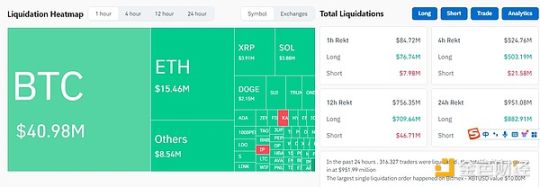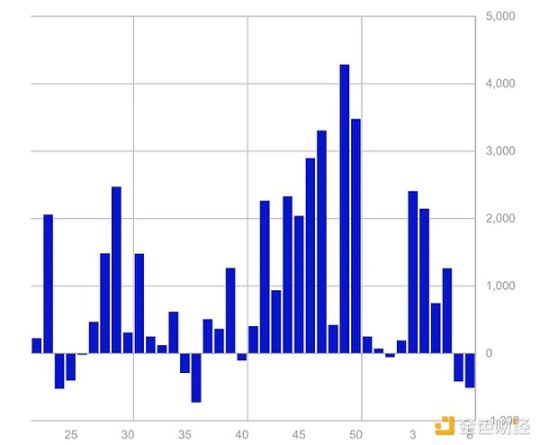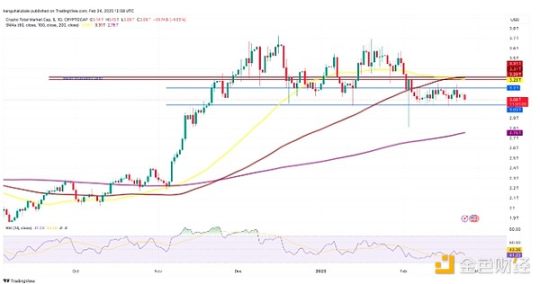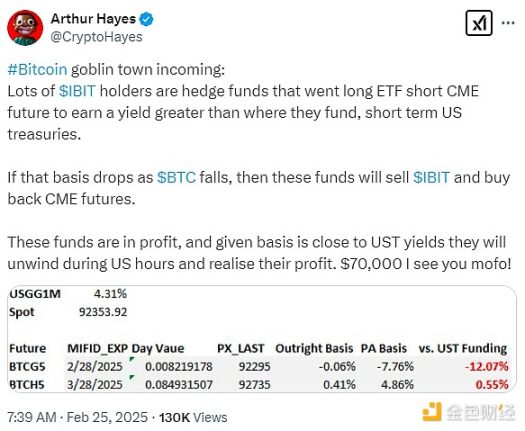Arthur Hayes believes that Bitcoin may drop to $70,000.
Compiled by: Deng Tong, Golden Finance
Several specific factors have led to the recent decline in cryptocurrency prices, including:
- The U.S. stock market struggles to shake off its recent slump, with Deepseek's impact on the market still fermenting.
- The cryptocurrency market is still recovering from the $1.4 billion hack incident at the Bybit exchange.
- Investors are in risk-averse mode amid continued outflows from cryptocurrency investment products.
- Strong upward resistance is hindering efforts to recover the global cryptocurrency market capitalization.
U.S. Stocks Drag Down Crypto Market
Following a significant drop last week, major U.S. stock indices attempted to rebound on Monday afternoon but failed, with the Nasdaq index closing down 1.2% and the S&P 500 index down 0.5%.
On February 21, local time, Trump signed a memorandum on the "America First Investment Policy." The memorandum aims to strengthen scrutiny of U.S. investments in China. As a result, Chinese concept stocks plummeted. The Nasdaq Golden Dragon China Index's decline widened to 5.24%, and the Wind Technology Leaders Index for Chinese concept stocks fell over 6%. Popular Chinese concept stocks all saw significant declines, with Alibaba and Bilibili dropping over 9%, and JD.com and Tencent Holdings falling over 7%.
Additionally, Deepseek's impact on the AI market continues to ferment. According to a report from investment bank TD Cowen, Microsoft has begun canceling leases for a large number of data center computing power in the U.S. or will not renew them, totaling several hundred MW, which may reflect Microsoft's concerns about building too much AI computing power. After DeepSeek launched an open-source AI model claiming to rival U.S. technology at extremely low costs, investors have expressed ongoing skepticism about the massive expenditures of tech giants, including Microsoft.
Furthermore, Nvidia's earnings report is raising concerns. On Wednesday, Nvidia will release its fourth-quarter earnings report. MarketWatch noted last week that this report will provide a more detailed look at its new Blackwell chip architecture. Production has accelerated, but these products face shortages, delays, and overheating issues, which reportedly have led some major clients to postpone orders. These issues have raised concerns about Nvidia's short-term financial health. Such concerns arise as investors assess the potential growth slowdown that large tech companies deeply involved in AI may face—typically, these companies bet on AI by investing billions of dollars and purchasing Nvidia's chips in large quantities. Analysts at Bank of America Securities stated in a report this month that Nvidia's earnings report will be "the next important test for the AI bull market," adding that Nvidia's earnings per share "is still substantial even without much hype."
Regarding the U.S. economy, Neil Dutta, head of economic research at Renaissance Macro Research, stated that risks facing the labor market are increasing. Real income growth is slowing, the real estate market is deteriorating, and state and local governments are cutting spending. Worryingly, the market generally believes that the economy will not slow down, with a median GDP forecast of around 2.5%.
Dutta wrote: "If 2023 is an unexpected rise, then 2025 is more likely to see an unexpected decline."
"The passive tightening of monetary policy is a major risk that has significant implications for financial market investors," Dutta continued. "I expect that as risk appetite weakens, long-term interest rates will decline, and stock prices will fall. In terms of the economy, the employment market is expected to worsen."
Ethereum Leads Market Plunge
Today's decline in the cryptocurrency market is part of an adjustment that began on February 21, when the Bybit cryptocurrency exchange was hacked, resulting in the loss of over $1.4 billion worth of ETH and ETH-related tokens, marking the largest cryptocurrency theft in history.
On February 25, the sell-off continued, including:
- Ethereum leading the market decline, down 11.5% in the past 24 hours, trading at $2,503.26.
- Bitcoin and Solana also saw declines, with Bitcoin down 4.9% at $91,549.81; Solana down 15.7% at $141.76.
- Other cryptocurrencies such as XRP fell 10.8%; Dogecoin down 13.7%; BNB down 6.5%.
The massive liquidations in the derivatives market have complicated matters.

The sell-off triggered the liquidation of leveraged positions, with a total of 316,393 traders liquidated in the past 24 hours, amounting to $952.08 million.
The dominance of long liquidations indicates that the cryptocurrency market is over-leveraged on the bullish side.
Despite the current bearish market sentiment, cryptocurrency options trading platform QCP Capital stated that cryptocurrency prices and implied volatility have shown a mild response compared to the FTX collapse in 2022.
QCP Capital stated in a Telegram message that this "highlights the increasingly mature landscape of cryptocurrencies," adding:
"Bybit was able to quickly secure bridge loans to fill liquidity gaps during critical times, underscoring the resilience and ample liquidity in the lending space. Since 2022, the industry has steadily recovered and experienced a significant surge before last year's U.S. presidential election."
Investors Continue to Avoid Cryptocurrency Risks
The ongoing adjustment in the cryptocurrency market aligns with capital outflows from cryptocurrency investment products.
Key points:
- Digital asset investment products have seen outflows for the second consecutive week;
- According to a report by CoinShares, the total outflow for the week ending February 21 was $508 million.
- This indicates that institutional investors are reducing their investments in digital assets.
- Bitcoin saw the largest outflow, totaling $571 million.
- Year-to-date inflows have decreased from $7.4 billion two weeks ago to $6.6 billion last week.

Capital flows of cryptocurrency investment products. Source: CoinShares
James Butterfill, head of research at CoinShares, attributed this to uncertainties surrounding trade tariffs, monetary policy, and inflation. He stated:
"We believe that after the U.S. presidential inauguration and the subsequent uncertainties regarding trade tariffs, inflation, and monetary policy, investors are remaining cautious."
Meanwhile, market participants are awaiting the final U.S. inflation data this week.
What to know:
- The Personal Consumption Expenditures (PCE) index, the Fed's "preferred" inflation indicator, will be released on February 28.
- Last week, initial jobless claims exceeded the median forecast by 4,000, reaching 219,000, indicating a weakening labor market.
- This significantly lowers expectations for multiple rate cuts in 2025.
- For example, according to the FedWatch tool from the Chicago Mercantile Exchange Group, despite two scheduled Fed meetings during this period, the likelihood of rate cuts is low.

Probability of target interest rates for the Fed's July 30 FOMC meeting. Source: CME
The current probability of the Fed maintaining interest rates at the next two meetings is: 97.5% for March and 73% for May.
Cryptocurrency Market Faces Significant Upward Resistance
The total market capitalization of all cryptocurrencies has declined as part of an adjustment that began on January 31, with key support areas turning into resistance.
Key points:
- The trading price of TOTAL is below the key supply area between $3.28 trillion and $3.31 trillion, which corresponds to the 50-day and 100-day simple moving averages (SMA).
- The Relative Strength Index (RSI) is currently at 40, indicating that market conditions still favor a downward trend.
- Additionally, the sell-off may push the cryptocurrency market down to the support level of $3.03 trillion.
- Note that this has been a key support area for TOTAL since November 20.
- A break below this level would trigger a sell-off, potentially dropping to the 200-day SMA of $2.72 trillion.

TOTAL/USD daily chart. Source: Cointelegraph/TradingView
Conversely, a push to increase the cryptocurrency market capitalization could bring it back to $3.2 trillion or higher to test the aforementioned resistance levels.
According to renowned analyst Crypto Zone, "the cryptocurrency market is in a neutral period," with the fear and greed index at 40.
The analyst added: "This indicates that investors are cautiously weighing their actions, and now is a critical moment for strategic decision-making."
BTC Bearish to $70,000
BitMEX co-founder Arthur Hayes stated on social media that many IBIT holders are hedge funds that earn returns above short-term U.S. Treasury yields by going long on ETFs and shorting CME futures. If the BTC price drop leads to a narrowing of the basis (i.e., the gap between ETF prices and futures prices), these funds will sell IBIT and cover CME futures. These funds are currently profitable, and considering the basis is close to U.S. Treasury yields, they will close positions during U.S. trading hours to realize profits. I am bearish to $70,000.

Quinn Thompson, founder of the crypto hedge fund Lekker Capital, which specializes in trading macroeconomic data, stated on social media: "I am trying to convey to those who may feel complacent/denial that $95,000 is still not a bad exit price relative to what I think we can trade in 6-12 months."
Thompson believes there is an 80% chance that Bitcoin will not reach a new high in the next three months and a 51% chance that it will not reach a new high in the next 12 months.
Source: Xinhua News Agency, Sina Finance, Securities Times, Wall Street Insights, Coindesk, CoinTelegraph, Twitter, etc.
免责声明:本文章仅代表作者个人观点,不代表本平台的立场和观点。本文章仅供信息分享,不构成对任何人的任何投资建议。用户与作者之间的任何争议,与本平台无关。如网页中刊载的文章或图片涉及侵权,请提供相关的权利证明和身份证明发送邮件到support@aicoin.com,本平台相关工作人员将会进行核查。




